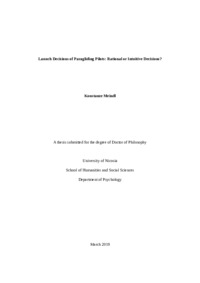- Meindl, Konstanze
- School of Humanities and Social Sciences
- Department of Social Sciences
- March 2019
- English
- 126 pages
- Grossenbrunner, Peter
- Paragliding | Decision-making | Dual-process theory | Pilots | Heuristics | Biases
- Psychology
- Original: Unic - Rules: RDA
-
-
The dual-process theory specifies two types of decision-making process: rational and intuitive. The intuitive decision-making process is based on heuristics, which lead to quick and often unconscious decisions. In this paper I investigate whether decisions made by paragliding pilots during launch are reached rationally or intuitively. The preliminary study was conducted as a structured interview with 34 paragliding pilots holding an Austrian, German, or Swiss licence. According to the pilots, they use the following for launch decisions: the availability heuristic, the majority heuristic, the sunk-cost fallacy, outcome bias, ability bias, framing, anchoring, the representativeness heuristic, the recognition heuristic, and confirmation bias. A total of 323 paragliding pilots took part in the main study, which is a questionnaire-based survey. I used structural-equation modeling to test whether the availability heuristic, the sunk-cost fallacy, the majority heuristic, risk-taking, and sensation-seeking predict the launch decision. This prediction was confirmed for the availability heuristic and the majority heuristic. I performed moderator analyses for the structural-equation model using multigroup analysis for age, type of licence, and number of flights in the previous year. One significant moderator effect was found: The availability heuristic predicts the launch decision for pilots who had few flights in the previous year but not for pilots who had a large number of flights in the previous year.
-
Launch Decisions of Paragliding Pilots: Rational or Intuitive Decisions?
Main Files
| Type | Location | Link |
|---|---|---|
| dissertation | [More information] |


